#golden age pulp
Explore tagged Tumblr posts
Text

STRANGE STORIES Vol 2, No 2 (Better Publications, 1939)
"DEATH IS FORBIDDEN!"
Art: Earle Bergey
(Manly Wade Wellman & August Derleth in here too!)
#pulp#pulp magazine#pulp art#pulp fiction#pulp horror#pulp illustration#magazine covers#horror#30s horror#1930s horror#golden age#golden age horror#golden age pulp#thriller#thrillers#manly wade wellman#august derleth#occult#magick#occultism#witchcraft
5 notes
·
View notes
Text
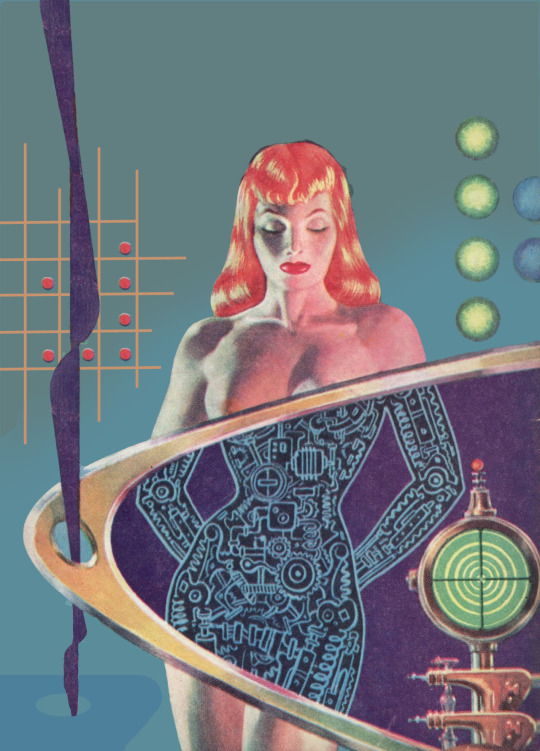
Super-Science Fiction Jun 1958
Frank Kelly Freas
#golden age art#pulp magazine art#pulp art#pulp art 1958#Super-Science Fiction#Kelly Freas art#byronrimbaud
737 notes
·
View notes
Text

Original Art - Golden Age Secret Files Pin-Up (2001) by Michael Lark
From ha.com...
The Crimson Avenger is profiled by Michael Lark in this 2000 drawing for a pin-up used in the one-shot published in 2001.
#Comics#DC Comics#Crimson Avenger#Michael Lark#Pulp Heroes#Pulp#Art#Original Art#DC#Golden Age Secret Files
45 notes
·
View notes
Text
Dieselpunk airplanes fantasy adventure is my favorite genre.

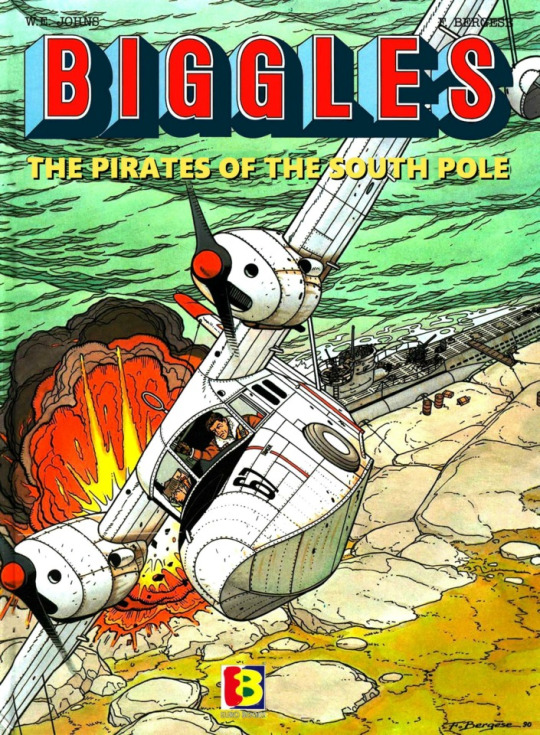

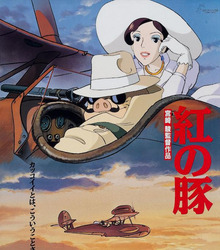




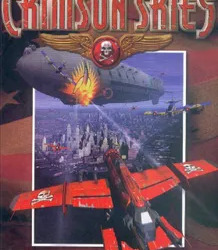

#dieselpunk#pulp fiction#golden age of comics#aviation#blackhawk#biggles#the rocketeer#porco rosso#sky captain and the world of tomorrow#talespin#tales of the gold monkey#air power battle in the skies#crimson skies#the sky crawlers#planes#airship#zeppelin
50 notes
·
View notes
Text

I got this ask on main but thought I'd pick it up here, my comics history/fashion ramble blog. I'd been wondering this exact same thing recently, and Google initially wasn't much help—Rocketeer replica jackets describe themselves only as "Rocketeer jackets" and the one Lobster Johnson cosplay thread just suggested ordering one of those.

The most curious part is the double seam and horizonal row of buttons that mark out the entire front as possibly being an unbuttonable "bib", like a plastron front. (Please don't ask how late in the game I worked out that "plastron" is the right word for that.)
The closest genuine Golden Age example of a plastron jacket I found was the military tunic style uniform of Blackhawk, created in 1941.

(Pics from the '52 movie serial (right) really show how awkward it is to combine open lapels + plastron. On a double breasted coat, that chest panel IS the bottom lapel, folded shut.)
Here's the thing: This outfit mirrors that of the Nazi ace pilot he fights in the origin issue, von Tepp (middle). And compare further to the far right: real life WWI flying ace Manfred von Richthofen, AKA the Red Baron, in imperial German Uhlan (lance cavalry) uniform.
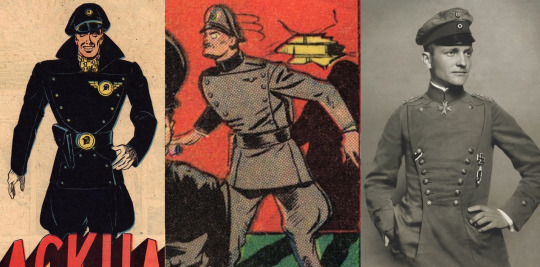
"The Germans had designed such great costumes, we decided to use them ourselves," co-creator Cuidera is quoted as saying in Steranko's History of Comics, which (more dubiously, in my opinion) compares the look to the Gestapo or SS. Breeches or jodhpurs weren't strictly a Nazi thing at the time, but they do add to the overall effect.
Compare two other military tunic themed costumes from 1940, on Captain Marvel and Bucky Barnes. These are asymmetrically buttoned, and switch to a more classic circus strongman look below the waist.

But somewhere around 1975, with the Invaders book, Bucky gets a buttoned bib! There's something infectious about it—the symmetry, maybe. (Even re: the characters we started with; Mignola didn't draw Lobster Johnson with buttons down the right side, but every artist after does. And Spider-Noir wore a sweater under his coat until Shattered Dimensions introduced the double-breasted vest.)
If it didn't reach his belt, Barnes' button-on front + shirt collar combo would resemble a bib-front western shirt, like the one that became the Rawhide Kid's signature look in '56. (Or Texas Twister's in '76.)
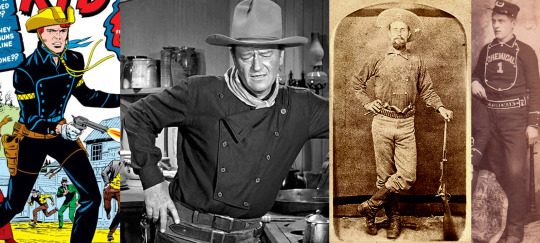
This shirt entered the old-West-obsessed public imagination in the 1940s/50s largely because John Wayne wore it in several cowboy movies. In reality it was rare among cowboys, more common with firefighters and civil war era militia.
Military tunics, Western shirts, alright, but does anything match the style and material and era, or are these jackets a total anachronism? I tried looking into 1930s leather flight jackets and was surprised when the closest-looking results were marked as Luftwaffe.
It took me a bit to work out why: USAF and RAF issued standard flight jackets with a center closure. The Luftwaffe instead let their pilots buy non-standardized ones. The 'weird' double-breasted black German flight jackets were in fact fairly normal (but repurposed) motorcycle racing jackets.
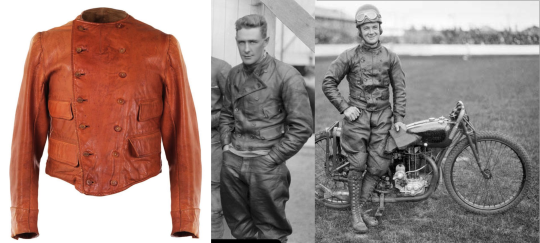
Far left is an English biker's jacket that dates back to the 1920s. Even without the bib, this may be as close as you'll get to an authentic Rocketeer. The jodhpurs were pretty common to complete the look. (What was an early motorcycle anyways, if not a weird metal horse?) The first biker jacket with the now iconic off-center diagonal zip was designed in America in 1928 and yet as far as I can tell, not a single actual pre-war pulp hero wore one.
The greatest weakness of this post is that I haven't been able to find any of these artists' notes on how, exactly, they arrived at similar versions of this iconic Pulp Front Panel Jacket. I'm sure I've missed some things. But as far as I can tell, this jacket is an odd bit of convergent stylistic evolution from the above influences that's picked up enough momentum to now be self-perpetuating.
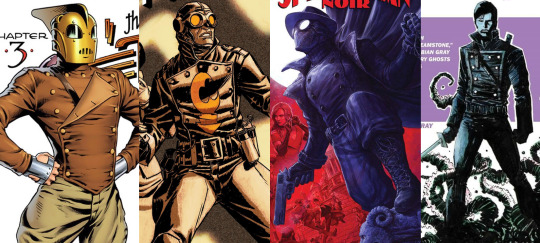
The problem with pulp heroes is that for the most part, they just wore clothes. The appeal of this jacket is actually very similar to what the 1940s thought the appeal of the bib-front shirt in westerns was: It's alien enough to feel "old". It looks like something invented before zippers or synthetic fabrics. It looks formal and militant but also renegade, rebellious. It also looks a little mad-sciencey*. It's a costume, but you can nearly fool yourself into thinking the past was weird enough that you could find something this cool on the rack.
If I wanted to end on some grand point, I could try to argue that there's a thematic throughline between fascist fashion, John Wayne movies, and throwback pulp. A manufactured aesthetic valorizing the violence of a fictional golden age... but I think the noir stylings of the post-Rocketeer comics in this lineup mean that, at least on some level, they know the "good guys" didn't dress like this.
*If I had another couple weeks of time to burn, I'd try to trace the visual history of the Howie coat in popular culture and investigate its possible connections to this. Alas, I do actually have a life.
#thank you for reading. also don't read golden age blackhawks the racism is awful even by era standards.#comics history#costume taxonomy#<- forgot I had that tag.#not to be like ''in MY favorite comics...'' again but may I point out that Hellboy and Robo and Tom Strong just wear... clothes#like. yknow. A pulp series that had confidence in itself rather than trying to cosplay as eras it thinks were cooler might do-#[I am yanked offstage before I can restart that rant]#the rocketeer
142 notes
·
View notes
Text

Battling Mothra's larvae back in old timey London!
48 notes
·
View notes
Text
We have to do a presentation at college for a piece of media that has influenced
you already know
#other people are doing pulp fiction or godfather#me? im doing the classics#the TRUE golden age of media#minecraft diaries#mcd#minecraft roleplay#aphmau mcd#aphmau minecraft diaries#aphblr
23 notes
·
View notes
Text
‘Sly look!’

Actress: Mary Anderson
Source: ‘Squads Riot’ (Sept, 1942)
#pin up style#pin up art#comic book art#pin up cartoon#good girl art#pulp art#pin up model#Hollywood#golden age#Mary Anderson#Squads Riot#1940s#1942#WW2#Magazine#comic
39 notes
·
View notes
Note
I’ve noticed once or twice among the pulp hero’s a dude with a crystal ball mysterio helmet in a dark suit. I can’t help but notice that what the Orb look is baller, it’s really distinct from other pulp characters he’s getting grouped with. What’s this guys deal and why is he so different from other pulp dudes?

(Meme on the left by Questionposting)
Ethel Knapp, twenty, stood in her furnished room and peered at the gas jet. For ten minutes she had been peering at it, trying to summon the courage necessary to turn it on—without a lighted match above it. She had no money. She had come to Great City from her home in Ohio to work. She had no work. She had no way of returning to her mother and father. But she did have a way of saving herself from further hunger and humiliation.
The gas jet.
She raised her hand toward it. Startled, she paused. A faint rustling sound came into the room. Looking down, she saw an envelope creeping under the door. She took it up, bewildered, and opened it. Inside lay money— currency held together by a band of silver paper—banknotes totalling $200!
“I can’t bear to see suffering, Angel. I can no more help trying to alleviate it than I can help breathing. If there were any other way of taking money from those who hoard it, and giving it to those who desperately need it—if there were any other way than stealing, I’d take that way. But there isn’t.” - The Sinister Sphere
This is The Moon Man. Moon Man was created by C. Frederick Davies and appeared in 38 stories from 1933 to 1937 and was a cross between The Shadow and Robin Hood, a black-clad urban avenger with a unique costume who stole from the rich to provide for the poor and was viciously hunted by law enforcement and the criminal underworld for it, not helped by the fact that his true identity is that of Stephen Tatcher, the 25-year-old police sergeant and son of the police chief, engaged to the daughter of his worst enemy, a lieutenant constantly trying to get Moon Man in the electric chair.
There's three main things that set The Moon Man apart from the other costumed pulp heroes and Shadow imitators from his day: Number one is that, despite looking a lot like Mysterio, he actually had much more in common with Spider-Man than even The Spider himself, in that he was mostly an ordinary schlub driven to help others who had to constantly pull off precarious balancing acts to keep his job and his secret and his life. 2nd being that he is a far more socially conscious character than pretty much all of his contemporaries, dealing with economic inequality, white collar crime, and grey areas where business practices and law enforcement intermingle with criminality to trample the lower class. He's a Depression-era Robin Hood and the stories are dead serious about it.
And third is that The Moon Man is no gentleman thief or dark avenger: He does none of this for the sake of personal fulfillment or revenge, he isn't tabling fights with gangsters to occasionally do an afterschool special or make a half-hearted gesture at social commentary, this is just what he does as a baseline. He is far less preoccupied with fighting crime than he is saving people in bad circumstances, and the stories are highly preoccupied with the people he saves, and the circumstances that The Moon Man is saving them from. For a weird guy in a creepy mask who goes around in a black coat with a gun in hand, he's an unexpectadly compassionate and soft-hearted (even mopey at times) character.
A chuckle came from the silver‐headed man. “You’ve distributed the money, Angel?”
“Yeah. Got it out right away. And it certainly was badly needed, boss.”
“I know… You realize why I selected Martin Richmond as a victim, Angel?”
“I’ve got an idea he ain’t all he seems to be.”
“Not quite that,” answered the voice that came from the silver head. “He’s quite respectable, you know. Social position, wealth, all that. But there’s one thing I don’t like about him, Angel. He’s made millions by playing the market short, forcing prices down.”
“Nothin’ wrong in that, is there?”, Dargan asked.
“Not according to our standards, Angel; but the fact remains that short‐selling had contributed to the suffering of those we are trying to help. I’ve taken little enough from Richmond’s kind, Angel. I must have more— later."
Dargan peered. “I don’t quite get you, boss. You’re takin’ an awful chance—and you don’t keep any of the money for yourself.”
A chuckle came from the silver globe. “I don’t want the money for myself. I want it for those who are perishing for want of the barest necessities of life. What would you do if you saw a child about to be crushed under a truck? You’d snatch her away, even at the risk of your own life."
“Don’t think I’m questioning you, boss.” Dargan hastened to explain. “I’m with you all the way, and you know it"
"Yes, Angel,” said the Moon Man gently, “I know it. You’re the only man in the world I trust. You know what it is to suffer; that’s why you’re with me”.
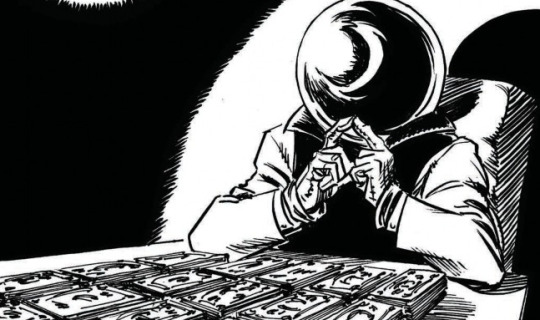
The Moon Man lacked much in terms of budget or resources, partially because all of his money went to people in need, and he was under constant threat from the law and underworld alike, each more bloodthirsty than the other in how badly they wanted to mount his Argus helmet on a platter (he didn't even make the helmet himself, he mail-ordered it under his detective arch-enemy’s name). His father is a police chief with a weak heart, which adds an extra pressure to Stephen's secret in that it being revealed will not only lead to his father being fired, but likely dying from shock.
He picks hide-outs with creaky stairs as his main line of defense against intruders, his only line of defense is a gun, he pined over the love of a stubborn lady who initially detested his alter-ego, but eventually learned his secret and grew into a stronger person and even partner as they got engaged. And he only has one other ally he can trust:
He’d gone bad in the ring. A weakened arm made further fighting impossible. He found it just as impossible to find work. He’d drifted downward and outward; he’d become a bum, sleeping in alleys, begging food. Until, mysteriously a message had come to him from the Moon Man.
Some day Ned Dargan was going to fight again. Some day he was going to get into the ring, knock some palooka for a row, and become champ. And if he ever did, he’d have the Moon Man to thank for it…
His main sidekick from the start, scarred ex-boxer Ned Dargan, was rescued by Moon Man from homelessness and starvation, and he was frequently named “Angel” as it was Dargan’s job to distribute the money, the narrative often filling the reader on the background of the recipients to make them not just anonymous victims, but real people with problems readers in the Depression era would have likely identified with. When we first meet them, Dargan tells him about a steamfitter with a sick daughter who needs money to pay for his kid's treatment, and a pair of kids with a recently deceased mother whose uncles can't afford to take them in and who will go to an orphanage without help, and The Moon Man promises money for all of them.
The main issue with the stories is that they do get a bit repetitive, but they're also fairly short and quick to read, and the strength of the concept, the assertive characters, the compassion, and the class dynamics that usually remain subtext in these kinds of stories, here becomes much of the text itself.
The Moon Man had a remarkable amount of continuity and consistency for a pulp hero, and only picked up more and more enemies that would constantly frame and target him with no additional allies. In fact, circa the end of the run, both his fiancé Sue as well as Angel are well acquainted with the Moon Man’s secret identity by this point and constantly beg Stephen Thatcher to give up his double life, warning him of increasing danger from both the cops and the mob, and in the last story, Blackjack Jury, he's pressured to give up his identity for good by the two and by how precariously his father's job hangs on him being able to capture Moon Man. The story and the character's run ends without revealing what decision he took.
Steve Thatcher lowered his head as though stubbornly to butt an obstacle. A wild scheme— his! He knew it. But, also, he knew the world— cruel and relentless—and he could not stand by and do nothing to save those who were suffering. The mere thought of letting others perish, while nothing was done to save them, was unendurable.
Beyond the written law was a higher one to which Steve Thatcher had dedicated himself—the law of humanity.
And if he were caught? Would he find leniency at the hands of Gil McEwen and Chief Thatcher? No. He was certain of that. Even if McEwen and the chief might wish to deal kindly with him, they would be unable to. The Moon Man now was a public enemy—his fate was in the hands of the multitude. Steve Thatcher would be dealt with like any common crook—if he were caught.
He remembered Ernest Miller’s daughter, who must go to Arizona or die; he remembered Frank Lauder, who must be cared for; he remembered Bill and Betty Anderson, who must have help.
“It’s got to be done!” he said through closed teeth. “Damn it, it’s got to be done!”
He walked swiftly through the night - The Sinister Sphere
The Moon Man is public domain and has seen some usage in modern pulp stories, but (as far as I can find) never really with the same bite that makes these stories appealing, and it's not difficult to see why the character, despite a fairly respectable run and a striking costume, remained mostly obscure. He certainly wouldn't have had any kind of 50s paperback revival without being heavily edited or rewritten entirely just in case somebody was maybe trying to trojan horse any commie talk somewhere, in a character whose main mission statement was addressing economic inequality and getting in trouble with the police over it. And nowadays, with Mysterio being so popular and "Moon Man" taking on a wholly different noxious meaning online, The Moon Man would require a slight overhaul of costume and a complete overhaul of his name, and unfortunately that entails almost making him a different character

The Moon Man stories were adapted into a short comics run circa 1940-42 where they completely overhauled his costume and changed the names, titling him The Raven, but otherwise kept the stories mostly the same. I don't have much of anything to say about him, but there is one additional bit of strangeness that followed The Moon Man's largely unsuccessful transition to comics: The Moon Man was never published in Brazil, but there was a Brazilian superhero in 1962 (which still predates Mysterio) with the exact same name and headpiece. Created by artist Gedeone Malagola who, upon being denied the opportunity to publish his own Phantom stories, simply erased the character’s head, added a cape and used a penny to draw a translucent globe for a head, creating a new hero in turn named Homem-Lua (Moon Man). The character lasted for a couple of years as a back-up on fellow superhero Black Ray’s magazine, before it’s end.
The only detail given about his past is that he was born in Brazil, initially operating near his headquarters in São Paulo before becoming a globetrotter. He lacks explicit superpowers, but is feared by criminals around the world and considered to be an immortal who’s been active for over a century, as many supporting characters in the stories claimed that their grandparents had met the hero. A master of technology who flew around in a personalized jet and was able to call upon the aid of indigenous tribes around the world, who believed him to bear the mark of a godlike entity or be said an incarnation of said entity (as a plot point it's as racist as you'd expect, but also gets a bit funny when you consider how the most famous of moon-themed superheroes this side of Japan, Moon Knight, would pan out 15 years later)
He's mostly a fairly cut-n-dry Phantom clone with some oddities here and there, namely: In one adventure, despite the character being supposedly a human, it was said that all who gaze on his face would die. He was never unmasked in the entirety of his run, and he had no compunctions about executing his villains, whether it was by burying them under a stone idol, breaking dams and letting them drown in the ensuing floods, exploding them, or outright sinking daggers into their chests. It's a very stark contrast to the pulp Moon Man, who preferred to avoid conflict entirely and would only use his gun as a last resort. Ultimately, they bear no official connection, but the strangeness of sharing the exact same name and trademark headgear. It's as if one ends where the other begins.
In some ways, I'd argue the original Moon Man is the purest wish fulfillment pulp hero of The Great Depression, because although eventually he'd take on more bizarre villains, the bulk of his stories are about this regular guy who goes around patching up wounds left by the Depression in a case-by-case basis and (barely) outfoxing and surviving repeated attacks from the powers that be only because he hides his true face from the world. He has no extraordinary abilities or resources, but he makes do as best he can with a ticking time bomb hanging above him.
As unfortunate as the character's present circumstances may be I absolutely think he's got what it takes to be striking and memorable and resonant in ways a lot of his fellow costume avengers aren't, and hey, the guy's public domain, so, if anyone wants to take a shot at reviving him or simply plopping him into a story, add another weird chapter to his history, nothing's stopping you. I simply have to believe there's an audience out there who may fall in love with a well-meaning bleeding heart trying his best who, with nothing but theatrics and smarts and a fishbowl helmet for a head, is driven to fight capitalism instead of Spider-Man.

With a strange, uncanny knowledge the Moon Man selected his victims. Those victims had climbed roughshod to power; some within the law, and others outside the pale. And the Moon Man called on them with a very definite and grim plan— for he walked in the eternal danger of a double menace. If the silent figure had any face at all, it was the face of the man in the moon!
#replies tag#pulp heroes#the moon man#pulp fiction#c frederick davies#superheroes#brazilian comics#golden age comics
137 notes
·
View notes
Text

Amazing Stories Vol 39 #1 by Virgil Finlay
#original comic art#pin up#splash page#virgil finlay#amazing stories#golden age comics#pulp magazine
25 notes
·
View notes
Text
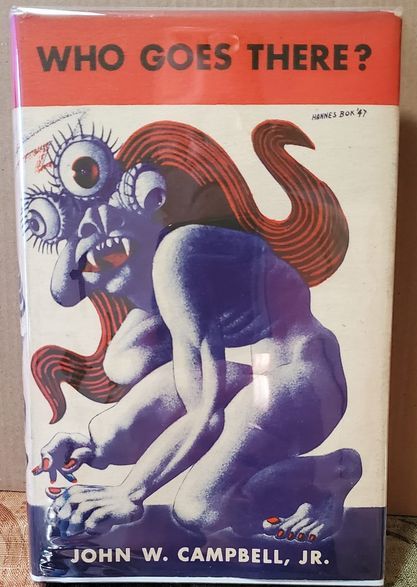
John W Campbell: "Who Goes There?" (Shasta, 1948)
Art: Wayne Francis Woodard aka "Hannes Bok"
The art has a weird Rich Corben vibe...
#john campbell#john w campbell#golden age#golden age science fiction#golden age pulp#science fiction#sci fi#40s science fiction#40s pulp#40s sci fi#1940s science fiction#1940s sc fi#1940s pulp#pulps#pulp science fiction#pulp#pulp horror#pulp fiction#pulp sci fi
38 notes
·
View notes
Text

Fantastic Universe Science Fiction Oct 1958
Virgil Finlay
#golden age art#pulp magazine art#pulp art#pulp art 1958#Fantastic Universe Science Fiction#Virgil Finlay art#byronrimbaud
855 notes
·
View notes
Text

Original Art - Golden Age Secret Files #01 Pg 01 (2001) by Cliff Chiang
From ha.com...
Page 1 of the story "The Dawn of the Golden Age" features the Crimson Avenger in bare-knuckled action! Originally created in the Shadow/Green Hornet mold, the Crimson Avenger (Lee Travis) was the first masked vigilante hero in DC's Universe. This story, written by John Ostrander, retconned the Lee Travis/Crimson Avenger origin, but kept the big strokes intact.
#Comics#DC Comics#Crimson Avenger#Cliff Chiang#Golden Age Secret Files#Art#Original Art#Pulp#Pulp Heroes#DC
15 notes
·
View notes
Text


|Pulp Covers
Weird Tales of September 1927 & October 1928.
8 notes
·
View notes
Text

art by SGTMADNESS
#The Addams Family#The Munsters#Elvira#Vampira#Frankenstein#The Bride of Frankenstein#retro#vintage#golden age#pulp
44 notes
·
View notes
Text

Another kaiju of the Golden Age.
12 notes
·
View notes